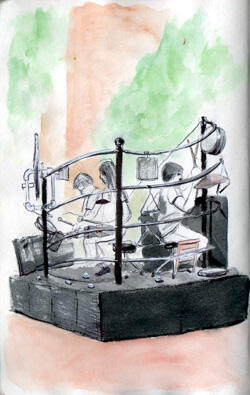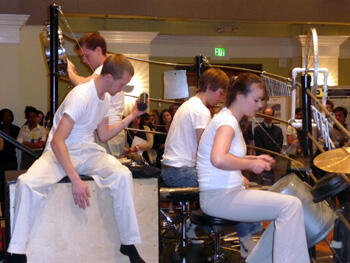April 27, 2009
VCUarts students find amusement in new sculpture-instrument
Share this story
“aMUSEment” research project: It’s a sculpture. It’s a musical instrument. And it’s a crowd-pleaser!

On a recent lighthearted Friday, clear and sunny and warm, a relaxed lunchtime crowd gathered in the small amphitheater between the Hibbs Building and the Singleton Center for the Performing Arts at VCU.
Two students practiced choreographed swordplay, a few others enjoyed lunch from the taco cart. One stretched a leg on the trunk of a small tree. An ice cream truck pulled alongside the curb on Linden Street playing “Pop Goes the Weasel,” and passers-by peeled off into a line.
Everything was as expected – except for one glaring peculiarity. Facing the amphitheater, arranged on a black box platform, four students performed a casual concert, playing on an elaborate construction of makeshift sounds.
The music was inventive, hypnotic and altogether different. The students – three men and a woman, each wearing white T-shirts and long khaki pants – played intensely, without smiles or even glances toward their audience.
The instrument, dubbed “aMUSEment,” was created this year by a collection of students in music performance, sculpture and graphic design. The project, which received funding from a VCU School of the Arts undergraduate research grant, serves by design as both a sculpture and an instrument – both a visual and musical piece of art.
The result is a complex creation that invariably catches viewers’ curiosity. Kevin Estes, a graduating senior in music performance and one of the students on the project, said surprise is the overwhelming response for most when they first encounter aMUSEment.

The instrument features such items as a metal sheet, a bucket, an overturned trash can, a bicycle wheel, a cymbal, xylophone keys and other overtly and covertly musical pieces. Five steel bars run through the piece, holding various music-makers and frequently serving as instruments themselves – players strike them with drum sticks.
When the performers play on aMUSEment, they work in individual stations and seamlessly, almost without notice, climb around the platform – “like it’s a playground,” Estes said – each student occupying each station during the course of a single performance. At the conclusion, the students descend from the platform, one at a time, receding into the crowd, the remaining students playing until there’s no one left.
Estes said the creators knew the aMUSEment’s sound wouldn’t be for everyone.
A major musical influence was John Cage, the avant-garde, experimental composer who offers challenges to his listeners, though the students hoped to create something entirely new, too. Estes said it can frustrate listeners that expect music to sound a certain way, likening it to the disappointment someone feels when a cover band’s version of a favorite song does not sound the same.
During the recent outdoor concert on campus, however, the crowd clearly found a lot to like, dancing and bobbing and offering a hearty applause when it was over. A few walked around the platform, studying the visual details of the piece.
Between its striking look and distinctive music, aMUSEment guarantees attention, whether from admirers or others.
“Even if you don’t like it, you have to stop and look at it,” Estes said.
Estes said the interdisciplinary nature of the project was demanding because of the participants’ differing perspectives and ideas for the concept. Sometimes the sound worked but the look did not, and sometimes the ideal look did not produce the desired sounds.
The work between the students wedding the two visions for the project was “the hardest thing I’ve ever done,” Estes said.
Other students who created aMUSEment and who now perform on it include Peter Soroka, a music student; John Labra, graphic design; and Brittany Shade, sculpture and extended media. Also working on the conception and construction of aMUSEment were sculpture students Nicholas Ireys and Rachel Ogburn; and music students Caitlin Bartgis and Stuart Jackson. Music professors Brian Jones and Kris Keeton and graphic design Professor Robert Carter advised, and the creators enlisted help from others, including a graphic design class.
The students ensured that aMUSEment would be mobile and therefore flexible to a performance schedule. The piece can be broken down easily into parts, transported to a concert venue and then reassembled. The students are hoping to find a permanent home for the instrument.
Although the aMUSEment performers do not smile much during a performance, if at all, their enthusiasm for the work is evident from the intent way they approach the effort and appear to immerse themselves deep in a performance, which is highly improvisational and collaborative.
One student discovers a sound that sparks responses and new directions from the others. The process can be fascinating and intimate for viewers.
“If you really pay attention when you watch us, you can see the conversation going on between us,” Estes said. “It’s a really cool experience.”
Subscribe to VCU News
Subscribe to VCU News at newsletter.vcu.edu and receive a selection of stories, videos, photos, news clips and event listings in your inbox.







